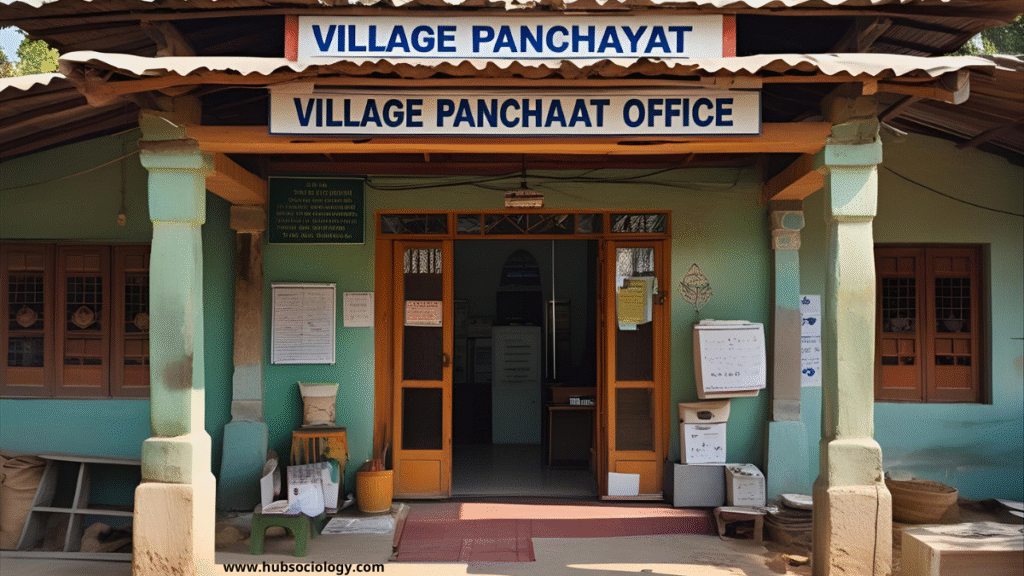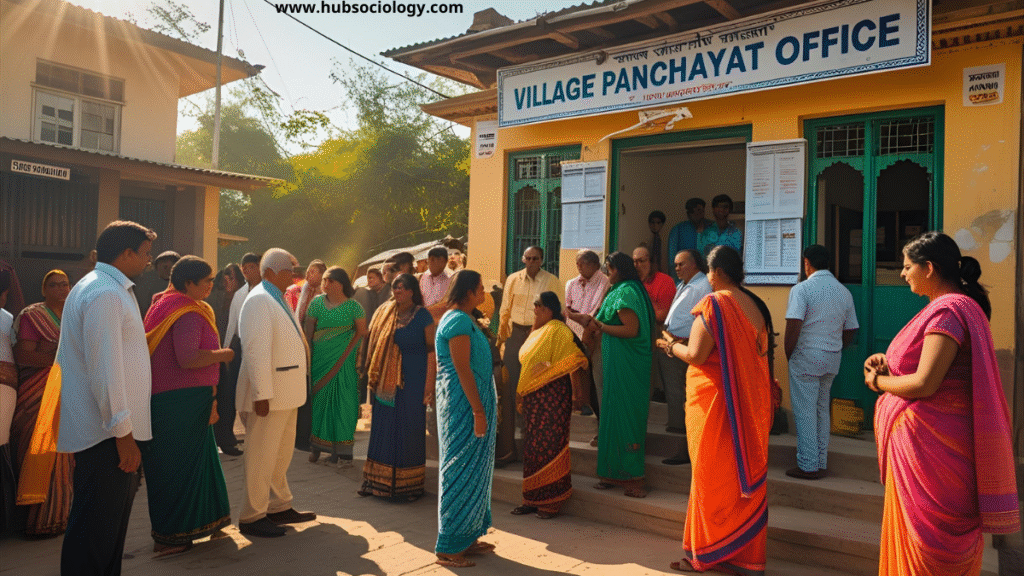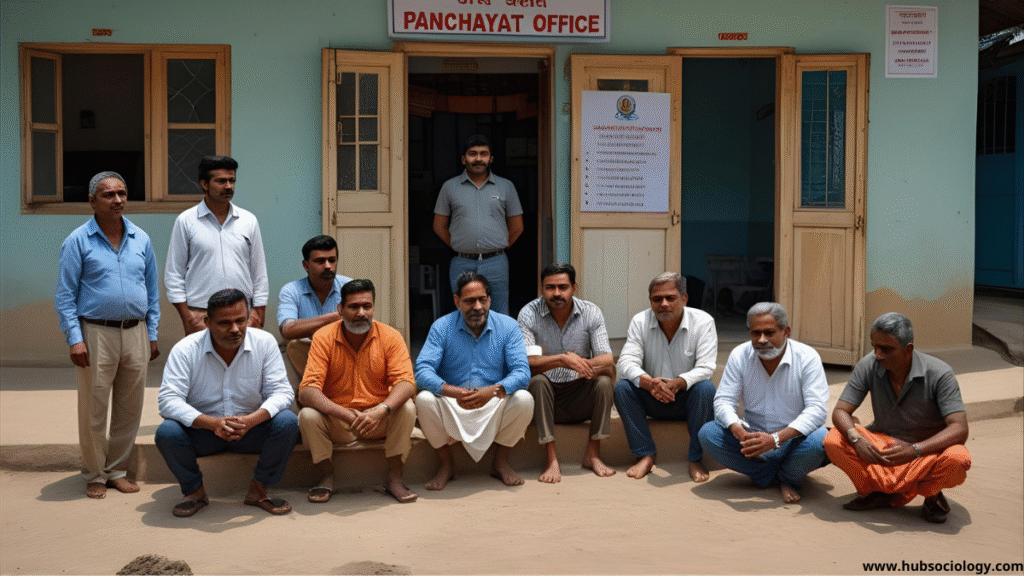Introduction
Political factionalism in rural society refers to the division of a community into rival groups or factions based on political allegiance, caste, kinship, religion, or local interests. It is a widespread phenomenon in rural India, where social and political life are deeply intertwined. Unlike urban politics, which often revolves around ideological or party-based competition, rural factionalism tends to be personal, kin-based, and rooted in traditional social structures. Sociologically, it reveals the dynamics of power, status, and authority in rural communities and reflects the transition from traditional to modern systems of governance.
This article explores the nature, causes, forms, and consequences of political factionalism in rural society, emphasizing its sociological dimensions.

Nature and Meaning of Political Factionalism
Factionalism can be understood as the formation of competing groups within a community or organization that seek to gain control, influence decisions, or protect their own interests. In rural India, factions often form around influential leaders, landlords, caste groups, or families. Political factionalism is not merely about competition for electoral power; it also involves the struggle for social prestige, economic resources, and control over local institutions such as the Panchayat, cooperative societies, and development programs.
In sociological terms, factionalism represents a form of social differentiation and conflict. It arises when traditional solidarity gives way to competing interests and when social change disturbs the established patterns of authority.
Sociological Background of Rural Factionalism
Rural India is characterized by a complex web of kinship ties, caste hierarchy, and patron-client relations. These traditional social structures deeply influence political behavior. According to sociologists like M.N. Srinivas and Andre Béteille, political factionalism in villages cannot be separated from their social organization.
- Caste: Caste remains a dominant factor in rural factional politics. People belonging to the same caste often form a faction to support one another in elections, disputes, or local development schemes. Rival castes form counter-factions.
- Kinship: Familial and kinship bonds serve as the foundation of group formation. Political loyalty often follows blood relations rather than ideology.
- Landownership: Landholding patterns and economic power play a major role. The dominant landowning class usually leads political factions to protect their control over resources and local institutions.
- Leadership: Local leaders emerge as patrons who distribute benefits, mediate conflicts, and mobilize followers. Factionalism often revolves around such figures rather than political parties themselves.
Thus, rural political factionalism is a sociological outcome of traditional hierarchies and localized power networks interacting with modern democratic institutions.
Historical Evolution
Before Independence, rural politics was dominated by landlords, moneylenders, and village headmen (zamindars, patels, or pradhans). The villagers had little participation in decision-making. After Independence, democratization and the Panchayati Raj system brought formal political power to the grassroots level. This opened opportunities for new groups and castes to participate in politics.
However, instead of eliminating old divisions, democratic competition often reinforced them. Traditional loyalties reappeared in new political forms. Elections at the village level became arenas for power struggles among factions representing different castes, kin groups, or economic classes. The introduction of party politics in local governance further institutionalized factionalism, as local leaders aligned themselves with state and national political parties to gain legitimacy and access to resources.
Causes of Political Factionalism in Rural Society
- Caste and Community Divisions:
Caste-based polarization is a primary cause. Villagers tend to vote and align themselves along caste lines. Caste organizations and networks influence political mobilization, leading to group rivalries. - Economic Inequality:
The unequal distribution of land, credit, and employment opportunities often leads to competition among groups for economic benefits. Political power becomes a means of securing economic advantages through government schemes or contracts. - Leadership Rivalry:
Ambitious local leaders compete for dominance and prestige. Factional rivalry intensifies when leadership positions in Panchayats or cooperatives are at stake. - Kinship and Personal Loyalties:
In many villages, politics revolves around kin-based factions. People support their relatives or patrons irrespective of party ideology. - Intervention of Political Parties:
State-level and national political parties often divide rural society by recruiting local leaders into their fold. These affiliations intensify existing divisions. - Developmental Benefits and Patronage:
Access to government programs, welfare schemes, and funds for development projects becomes a major source of conflict. Factions emerge to control these benefits and distribute them among supporters. - Cultural and Historical Rivalries:
Old enmities, disputes over land, or past village conflicts often carry forward into modern political competition, deepening factional divides.
Forms and Manifestations of Factionalism

- Party-Based Factionalism: When national or regional political parties extend their influence to villages, local leaders align themselves with them, creating party-based factions.
- Kinship-Based Factionalism: Rivalries within large kin groups or clans lead to division in village politics.
- Caste-Based Factionalism: Different caste groups form coalitions or counter-coalitions to assert their political dominance.
- Issue-Based Factionalism: Occasionally, factions arise around developmental issues such as irrigation, land disputes, or employment schemes.
These forms often overlap, creating a complex mosaic of overlapping loyalties in the rural political structure.
Consequences of Political Factionalism
- Positive Consequences:
- Political Participation: Factionalism increases political awareness and participation, as villagers become more involved in electoral processes.
- Social Mobility: Lower castes and marginalized groups sometimes use factional alliances to gain access to power and resources.
- Accountability: Rival factions may keep each other in check, preventing absolute domination by a single group.
- Negative Consequences:
- Social Division: It deepens social and caste conflicts, weakening community unity and cooperation.
- Violence and Tension: Electoral competition often leads to violence, boycott, or social exclusion.
- Developmental Obstruction: Factional rivalry hampers the effective implementation of development schemes. Funds may be misused or distributed unequally.
- Corruption and Nepotism: Political patronage and favoritism become common, eroding democratic values.
- Decline of Collective Institutions: Cooperative societies, Panchayats, and village committees lose their efficiency due to factional interference.
Thus, political factionalism simultaneously strengthens and weakens rural democracy—enhancing participation while undermining harmony and collective welfare.
Sociological Theories on Factionalism
From a sociological viewpoint, political factionalism can be analyzed through several theoretical perspectives:
- Structural-Functional Perspective:
According to this view, factionalism serves as a mechanism of political integration and participation. It allows different groups to express interests and channel conflicts within a democratic framework. - Conflict Perspective:
From Karl Marx’s standpoint, factionalism reflects class struggle and competition for resources. The ruling groups use factional politics to maintain control, while the oppressed use it as a means of resistance. - Weberian Perspective:
Max Weber’s concept of power and authority explains factionalism as a contest for legitimacy. Local leaders seek to convert personal charisma into political authority through factional support.
These perspectives help us understand factionalism not merely as disorder but as an expression of underlying social dynamics and power relations.
Conclusion
Political factionalism in rural society is a product of India’s socio-cultural diversity and its transitional phase between traditional and modern systems. It represents both continuity and change—continuity of caste, kinship, and local loyalties, and change through the spread of democracy and modernization.

While factionalism often disrupts unity and development, it also indicates a politically awakened rural population. The challenge lies in transforming factional competition into constructive participation. Strengthening democratic institutions, promoting political education, and ensuring equitable distribution of resources can help reduce destructive factionalism and foster genuine rural development.
In the sociological sense, political factionalism is not merely a political issue—it is a mirror of rural society’s structure, conflicts, and aspirations.
Do you like this Article ? You Can follow as on :-
Facebook – https://www.facebook.com/hubsociology
Whatsapp Channel – https://whatsapp.com/channel/0029Vb6D8vGKWEKpJpu5QP0O
Gmail – hubsociology@gmail.com
Topic Related Questions
5 Marks Questions (Short Answer Type)
- What is meant by political factionalism in rural society?
- Mention two major causes of political factionalism in Indian villages.
- How does caste influence political factionalism in rural areas?
- Define factionalism with one sociological example from rural India.
- State any two positive effects of political factionalism in rural politics.
- What is the role of Panchayati Raj institutions in shaping political factionalism?
- Who are the major actors or leaders involved in rural factional politics?
- Mention two consequences of political factionalism for rural development.
- What is kinship-based factionalism? Give a brief explanation.
- How does economic inequality contribute to factional rivalry in villages?
10 Marks Questions (Medium Answer Type)
- Discuss the major causes of political factionalism in rural society.
- Examine the relationship between caste and political factionalism in Indian villages.
- Explain the sociological background of factionalism in rural India.
- How does the introduction of democratic institutions like Panchayati Raj influence factional politics?
- Discuss the role of leadership rivalry in the emergence of political factions in rural areas.
- What are the major consequences of factionalism on rural governance and development?
- Explain the forms and manifestations of political factionalism in rural communities.
- Discuss how modernization and political parties have transformed traditional factional structures.
- How does factionalism affect the functioning of cooperative societies in villages?
- Examine the impact of political factionalism on social unity and village solidarity.
15 Marks Questions (Long Answer / Essay Type)
- Discuss the nature, causes, and consequences of political factionalism in rural society from a sociological perspective.
- Critically examine the relationship between traditional social structures (caste, kinship, and landownership) and modern political factionalism in Indian villages.
- Analyze political factionalism as both a product and a reflection of rural social change in India.
- Evaluate the impact of political factionalism on the functioning of Panchayati Raj and rural development programs.
- Discuss political factionalism in rural society using sociological theories — functional, conflict, and Weberian perspectives.
- “Political factionalism strengthens democracy but weakens social harmony.” Discuss this statement with sociological examples.
- Trace the historical evolution of political factionalism in rural India since Independence.
- Examine the role of economic inequality and leadership competition in shaping rural factional politics.
- How can destructive factionalism in rural society be transformed into constructive political participation? Suggest sociological measures.
- Analyze political factionalism as a mirror of the power structure in rural India.
